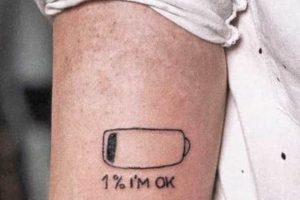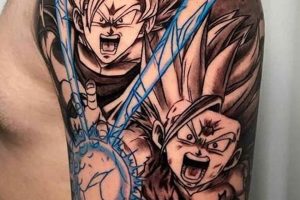Literary-inspired body art represents a growing trend. These designs can range from simple textual excerpts and iconic imagery to complex, illustrative scenes depicting favorite characters or narratives. Examples include minimalist outlines of beloved books, portraits of authors, or symbolic representations of key themes and motifs.
Permanent markings drawn from literature allow individuals to express personal connections with specific works, authors, or literary movements. They can serve as a constant reminder of a powerful story, a cherished character, or a formative reading experience. Historically, the practice of inscribing words and symbols on the body has served as a powerful form of self-expression and cultural affiliation. In the modern context, literary tattoos continue this tradition, offering a unique and enduring way to showcase intellectual passions and aesthetic preferences.
This exploration will delve further into the diverse world of literary-themed body art, covering various design options, stylistic choices, and the cultural significance imbued within these permanent expressions of literary appreciation.
1. Quotes
Quotes serve as a powerful element within literary tattoos, offering a concise yet impactful way to encapsulate core themes, memorable dialogue, or inspiring prose from beloved books. The selection of a quote often reflects a deeply personal connection to a specific work, highlighting a passage that resonated with the individual on an emotional or intellectual level. This connection transforms the tattoo into a permanent reminder of a significant literary experience. For example, a line from “To Kill a Mockingbird” such as “You never really understand a person until you consider things from his point of view…” can serve as a powerful statement of empathy and understanding.
The visual representation of quotes offers considerable artistic flexibility. Typography plays a crucial role, allowing individuals to personalize the aesthetic through font choices, calligraphy styles, or even incorporating elements of the book’s cover design. Furthermore, quotes can be interwoven with other visual elements, such as symbolic imagery or character portraits, to create a more complex and layered design. A quote from “The Little Prince,” for instance, could be paired with an image of the prince himself, enhancing the visual narrative and deepening the personal meaning.
Choosing a quote for a literary tattoo requires careful consideration of both its personal significance and its aesthetic potential. Shorter quotes often lend themselves to cleaner, more minimalist designs, while longer passages might require more intricate typographic arrangements or larger canvas areas. Regardless of length, the selected quote should encapsulate the essence of the individual’s connection to the literary work, ensuring a lasting and meaningful tribute to the power of written language.
2. Characters
Character-based designs offer a visually compelling approach to literary tattoos. Depicting a beloved character allows for a direct visual representation of a reader’s connection to a specific narrative. This choice often reflects a deep admiration for the character’s personality, their role within the story, or their symbolic representation of broader themes. Visual interpretations can range from realistic portraits to more stylized or symbolic depictions. A portrait of Atticus Finch, for example, might represent justice and moral courage, while a silhouette of Jay Gatsby could symbolize the elusive pursuit of the American Dream. The character’s visual depiction can be further enhanced by incorporating elements of their attire, iconic objects they possess, or key scenes in which they appear.
The design process for character tattoos often involves careful consideration of artistic style. A minimalist line drawing can capture the essence of a character with simple elegance, while a more detailed, illustrative approach can portray complex emotions and nuanced personality traits. The chosen style should complement the character’s nature and the individual’s personal aesthetic preferences. For instance, a whimsical character from children’s literature might be rendered in a light, playful style, whereas a character from a gothic novel could be depicted with darker, more dramatic imagery. The chosen style can also influence the tattoo’s placement and size, ensuring a harmonious integration with the body’s contours.
Ultimately, a character-focused literary tattoo serves as a lasting tribute to a fictional figure who has resonated deeply with the reader. It allows individuals to externalize their admiration for a character’s qualities, their journey within the narrative, or their symbolic representation of universal human experiences. By carefully considering artistic style, composition, and symbolic details, these tattoos can transform beloved literary figures into powerful and personal works of art.
3. Open Books
Open book imagery holds a prominent position within the realm of literary tattoos, symbolizing the act of reading, the pursuit of knowledge, and the transformative power of stories. These designs offer a versatile canvas for personal expression, allowing individuals to showcase their love of literature in a visually engaging manner. The open book motif can be adapted to incorporate various elements, from specific passages and quotes to symbolic imagery and artistic embellishments, making it a popular choice for those seeking a meaningful and aesthetically pleasing literary tattoo.
- Visual Representation of Reading
An open book serves as a direct visual metaphor for the act of reading itself. It represents the immersion in a story, the absorption of knowledge, and the connection between reader and text. This symbolism resonates deeply with individuals who find solace, inspiration, or escape within the pages of a book. The image can be as simple as a minimalist outline of an open book or as detailed as a realistic depiction of a well-worn favorite, complete with creased pages and dog-eared corners.
- Incorporation of Textual Elements
Open book designs provide an ideal framework for incorporating specific textual elements. A favorite quote, a meaningful passage, or even a single word can be inscribed within the open pages, adding a layer of personal significance to the tattoo. This allows individuals to showcase a particular piece of writing that has resonated with them, transforming the tattoo into a permanent reminder of a powerful literary experience. For example, a passage from a beloved poem or a line from a play can be visually integrated into the open book design, creating a harmonious blend of image and text.
- Symbolic Gateway to Other Worlds
The open book can also be interpreted as a symbolic gateway to other worlds, reflecting the transformative power of literature to transport readers to different times, places, and perspectives. This imagery resonates with those who find solace and escape in fictional narratives. The open pages can be depicted as leading into fantastical landscapes, historical settings, or even abstract realms of thought and imagination, visually representing the boundless possibilities contained within the written word. This symbolism adds a layer of depth and intrigue to the tattoo, inviting viewers to contemplate the power of stories to shape our understanding of the world.
- Adaptability to Diverse Artistic Styles
The open book motif offers remarkable adaptability to diverse artistic styles. From minimalist line drawings to intricate illustrative renderings, the design can be tailored to reflect the individual’s personal aesthetic preferences. The book itself can be depicted in various styles, from classic and traditional to modern and abstract. Furthermore, the surrounding elements, such as flowers, birds, or other symbolic imagery, can be incorporated to enhance the visual narrative and create a unique and personalized piece of art. This flexibility allows individuals to express their love of literature in a way that aligns with their individual artistic sensibilities.
In conclusion, the open book tattoo serves as a powerful and versatile symbol of literary appreciation. By incorporating textual elements, symbolic imagery, and personalized artistic styles, these designs offer a unique and enduring way to showcase one’s connection to the written word. The open book, in its various forms, represents the transformative power of literature and its enduring impact on individual lives.
4. Symbolic imagery
Symbolic imagery plays a crucial role in enriching literary tattoos, offering a nuanced and layered approach to expressing personal connections with books. Rather than directly representing a title or character, symbolic imagery draws upon deeper themes, motifs, and metaphors within the narrative. This allows for a more subtle and evocative representation of the literary work, inviting interpretation and reflection. The chosen symbol acts as a visual shorthand for complex ideas and emotions, encapsulating the essence of the story in a concise and powerful way. For instance, a raven, inspired by Poe’s poem, might symbolize death, mystery, or lost love, while a tree could represent growth, knowledge, or the interconnectedness of life, as seen in “The Giving Tree.”
The effectiveness of symbolic imagery in literary tattoos lies in its ability to evoke personal meaning while maintaining a degree of artistic ambiguity. The same symbol can hold different interpretations for different individuals, allowing for a personalized and subjective engagement with the literary work. A single image can encapsulate a multitude of meanings, reflecting the complexity and depth of the narrative itself. This open-ended quality encourages dialogue and deeper exploration of the literary themes, enriching the tattoo’s significance for both the wearer and the observer. For example, a compass, inspired by “The Golden Compass,” could represent guidance, exploration, or the search for truth, depending on the individual’s interpretation and personal connection to the story.
Selecting appropriate symbolic imagery requires careful consideration of the literary work’s core themes and the individual’s personal interpretation of those themes. The chosen symbol should resonate deeply with the individual, capturing the essence of their connection to the story. Researching the historical and cultural significance of potential symbols can further enrich the tattoo’s meaning, adding layers of depth and complexity. The size, placement, and artistic style of the tattoo should also complement the chosen symbol, ensuring a cohesive and aesthetically pleasing design that effectively conveys the intended meaning. Ultimately, symbolic imagery offers a powerful and evocative way to express one’s appreciation for literature, transforming abstract ideas and emotions into tangible and enduring works of art.
5. Cover Art
Cover art represents a significant source of inspiration for literary tattoos, offering a direct visual link to a cherished edition. Reproducing or adapting cover art allows individuals to showcase their appreciation for a specific book while also acknowledging the artistic merit of the design itself. This approach can range from replicating the entire cover to incorporating key elements, such as typography, color palettes, or central imagery. The choice often reflects a deep connection not only to the narrative but also to the physical object and its aesthetic qualities. For example, replicating the iconic cover of “The Great Gatsby” with its melancholic eyes overlooking a cityscape can serve as a powerful visual representation of the novel’s themes and atmosphere. Similarly, incorporating the stylized bird from a specific edition of “To Kill a Mockingbird” can demonstrate a personal connection to that particular version of the classic novel. This approach offers a unique way to showcase both literary and artistic appreciation.
The process of adapting cover art for a tattoo involves careful consideration of the design’s complexity and the desired level of detail. Simpler designs often translate well to smaller tattoos, while more intricate covers may require larger canvases or a degree of simplification to retain their visual impact. Working closely with a skilled tattoo artist is crucial to ensure the chosen design translates effectively to the medium of skin. The artist can advise on appropriate sizing, color palettes, and stylistic adaptations to create a tattoo that is both aesthetically pleasing and faithful to the original artwork. Considerations such as the placement of the tattoo and its interaction with the body’s contours further influence the adaptation process. For example, a wrap-around design might be suitable for an arm or leg, while a smaller, more focused element might be better suited for a wrist or ankle. This collaborative approach ensures a successful translation of the cover art into a lasting and meaningful personal expression.
Cover art tattoos offer a compelling intersection of literary appreciation and visual aesthetics. They provide a tangible connection to specific editions, showcasing an appreciation for both the narrative and the artistic design. By carefully considering the complexities of adaptation, individuals can create tattoos that serve as enduring tributes to beloved books and their visual representations. This approach allows for a personalized expression of literary fandom that transcends the simple act of reading and embraces the broader artistic and cultural significance of book design.
Tips for Literary Tattoos
Careful planning ensures a literary tattoo remains a source of pride and personal meaning. Consider these essential factors before committing to a permanent design.
Tip 1: Research and Selection: Thoroughly research potential designs, considering their literary significance and personal resonance. Explore various interpretations and symbolic meanings associated with chosen elements. Example: Investigate the symbolism of a raven before incorporating it into a Poe-inspired tattoo.
Tip 2: Collaboration with a Skilled Artist: Seek a tattoo artist specializing in the desired style, whether minimalist, illustrative, or watercolor. Discuss design ideas, placement, and sizing to ensure a harmonious and technically proficient outcome. A skilled artist can translate literary concepts into visually compelling tattoos.
Tip 3: Placement and Size: Consider the tattoo’s visibility and how it interacts with the body’s contours. Smaller, simpler designs suit discreet locations, while larger, more complex pieces require ample space. Placement impacts overall aesthetic and should complement the design.
Tip 4: Typography Considerations: For text-based tattoos, carefully select fonts that complement the literary work’s style and era. Discuss font choices with the artist to ensure legibility and visual harmony within the overall design. Illegible script diminishes the tattoo’s impact.
Tip 5: Color Palette: Thoughtfully consider the color palette, recognizing its impact on mood and symbolism. Monochromatic palettes offer classic elegance, while vibrant colors can enhance visual impact. Discuss color choices with the artist for optimal results.
Tip 6: Long-Term Considerations: Recognize tattoos are permanent. Ensure chosen designs retain personal significance over time. Avoid trendy elements that might lose relevance. Timeless designs ensure lasting satisfaction.
Tip 7: Budgetary Planning: High-quality tattoos require investment. Research artist rates and factor costs into budgetary planning. Prioritize quality over cost to avoid unsatisfactory results.
Careful planning and collaboration with a skilled artist result in a literary tattoo that effectively captures personal connections to cherished works, ensuring a lasting and meaningful piece of body art.
These tips provide a solid foundation for embarking on the journey of acquiring a literary tattoo, ensuring the final result becomes a cherished and enduring expression of personal literary passion.
Frequently Asked Questions about Literary Tattoos
This section addresses common inquiries regarding literary-inspired tattoos, offering practical guidance and clarifying potential concerns.
Question 1: How does one choose an appropriate literary quote for a tattoo?
Quote selection hinges on personal resonance and intended message. Consider passages holding deep personal meaning, reflecting core values or inspiring life philosophies. Brevity is often advantageous for tattoo design, though longer passages can be accommodated through skilled typographic arrangement.
Question 2: What factors influence the cost of a literary tattoo?
Several factors impact cost, including size, complexity, color palette, artist’s experience and hourly rate, and geographic location. Detailed, multi-session pieces by renowned artists command higher prices than smaller, simpler designs by less experienced practitioners.
Question 3: Are certain literary works more suitable for tattoo adaptation than others?
No inherent limitations restrict literary sources. Personal preference dictates source material. Classic novels, contemporary poetry, children’s literature, and even song lyrics can inspire meaningful tattoos. The chosen work’s significance to the individual determines its suitability.
Question 4: How can potential pain during the tattooing process be managed?
Pain tolerance varies. Discuss pain management strategies with the chosen artist. Options include topical anesthetic creams, over-the-counter pain relievers, and maintaining proper hydration and nutrition before the session. Open communication with the artist ensures a comfortable experience.
Question 5: What aftercare procedures are essential for preserving the quality of a literary tattoo?
Proper aftercare is crucial. Follow the artist’s specific instructions meticulously. General guidelines include keeping the tattoo clean, moisturized, and protected from sun exposure during the healing process. Proper aftercare preserves vibrancy and longevity.
Question 6: Can literary tattoos be modified or covered up if desired?
Modification or cover-up options exist. Consult a skilled artist to discuss possibilities. Adding elements, altering colors, or incorporating the existing tattoo into a larger design can effectively address dissatisfaction. Laser removal remains an option, though a more complex and costly process.
Careful consideration of these frequently asked questions ensures a well-informed decision-making process, contributing to a positive and fulfilling literary tattoo experience.
For further exploration, the subsequent sections delve into specific examples of successful literary tattoo designs, showcasing diverse styles and offering further inspiration.
Book Tattoo Ideas
This exploration has traversed the multifaceted landscape of literary-inspired body art, examining diverse design options ranging from concise quotes and symbolic imagery to intricate character portraits and evocative cover art adaptations. Key considerations such as placement, typography, color palettes, and collaboration with skilled artists have been emphasized as crucial elements for achieving successful and meaningful results. Furthermore, practical guidance regarding research, budgetary planning, and long-term care ensures informed decision-making for those embarking on this expressive journey.
Literary tattoos offer a powerful medium for externalizing personal connections with cherished narratives and literary figures. They transform ephemeral reading experiences into enduring expressions of intellectual passion and artistic appreciation. As the art of tattooing continues to evolve, the potential for innovative and evocative literary-themed designs remains boundless, offering a timeless canvas for celebrating the enduring power of the written word.







